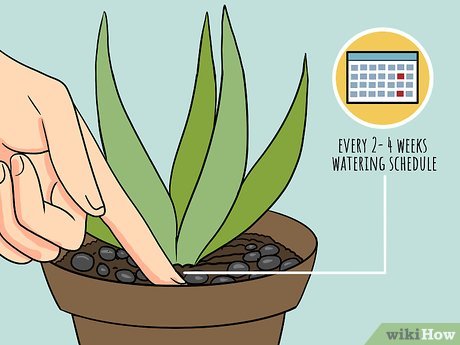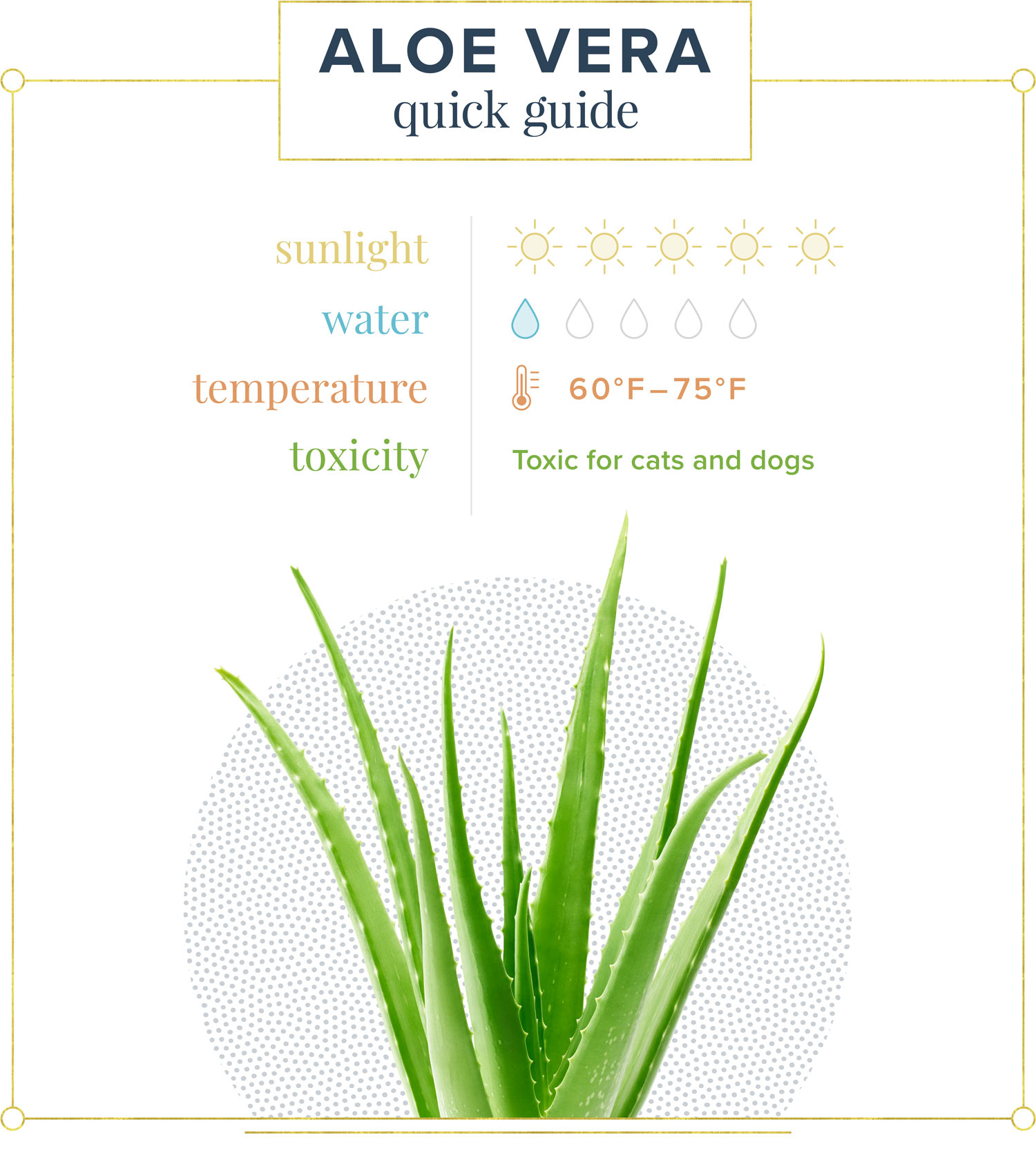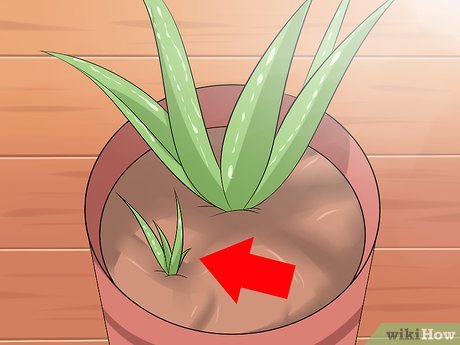
Aloe vera plants can withstand drought and should only be watered once the soil surrounding the roots has completely dried out. Aloe vera is typically watered once every 14 days, allowing the soil to dry out in between applications in order to meet its water needs without risking root rot.
Aloe vera must be watered properly to avoid root rot, which is brought by over watering and soils with poor drainage.
Aloe vera enters a state of dormancy in response to hot temperatures in the Summer as a survival strategy to conserve water, therefore they have varying water needs at different times of the year.
As a result, the water requirements of aloe vera change throughout the year.
To reduce the risk of root rot, aloe vera should be watered properly in combination with the proper well-draining, succulent and cactus soil mix.
Continue reading to learn the proper potting mix to use and how much and how often to water your aloe in the summer and winter to keep it healthy.
Table of Contents
How Often to Water Aloe Vera (Indoors and Outdoors)
Aloe Vera plants are succulents that are adapted to growing in full sun, frequent drought, and little rain environments.
The purpose of their large, fleshy leaves is to hold as much water as possible.
Aloe vera are highly vulnerable to overwatering when grown by gardeners because they are accustomed to harsh, hot, and dry regions.
In order to efficiently water aloe vera, you must mimic the drought conditions that they are acclimated to while still meeting their moisture needs in their natural environment.
Only after the soil around the roots has completely dried out should aloe vera be watered. Usually, this entails drinking aloe vera water once every 14 days.
The time it takes for the soil to dry around the roots, however, varies based on many growing circumstances, such as:
- Your climate’s humidity levels and temperatures (greater humidity lowers aloe water consumption by reducing water loss from the leaves).
- The pot’s or containers’ size (smaller pots dry out much quicker then larger pots).
- Whether the aloe is outdoors, in a more open space, or both indoors and in a current of forced air or air conditioning (excess wind can sap moisture from the leaves).
- The speed at which soil drains (aloe vera needs to be planted in well draining soil).
Feeling the soil at the bottom of the pot through the drainage hole to check whether it is damp or dry is the most accurate technique to determine how frequently to water aloe vera plants to suit your environment.
If the soil seems wet, wait another day or two before watering; however, if the soil feels dry, water your aloe vera plant now.
The best approach to replicate the aloe’s natural watering cycle is to do it this way, which gives the plant the water it needs to grow and stay healthy while also allowing the soil to dry out enough to prevent problems with root rot.
Whether your aloe is indoors or outside, you may design a watering schedule using the same strategy because root rot brought on by excessive watering is always the largest hazard to an aloe vera plant.
However, it’s crucial to remember that aloe vera reduces its need for water as a drought survival tactic by entering a state of dormancy in response to high summer temperatures.
Aloe also requires less frequent watering during the winter.
How Often to Water Aloe Vera in the Summer
Aloe Vera go dormant throughout the summer as a water-saving measure during the warmest and driest season of the year.
If the temperature is high enough during their Summer dormancy, aloe vera practically stops growing, which dramatically lowers its need for water.
(Read my post to learn why aloe vera stops growing and how to fix it; there are multiple potential causes).
The aloe vera typically slows down in growth when temperatures regularly reach 80°F (27°C) in order to save moisture.
It may be necessary to dial back how frequently you water during the hotter Summer months when the aloe plant is more vulnerable to the effects of overwatering.
During the hottest weeks of Summer, watering Aloe Vera once every three weeks is usually sufficient while the plant is dormant.
With less frequent rainfall, longer stretches of high temperatures, and drought, this decreased frequency of watering mimics the Summer circumstances of the aloe’s native environment.
How Often to Water Aloe Vera in the Winter
In the winter, aloe plants require less watering for a variety of reasons.
- The ideal temperature range for growth is 13°C to 27°C, or 55°F to 80°F. The growth rate slows down and the aloe vera need less water if your winter temperatures are persistently below 55°F.
- Low sunshine intensity and fewer sun hours. Winter’s shorter days cause the aloes’ growth to slow down, as does the speed at which the soil dries out.
- Winter temperatures cause the soil to remain moist for a longer period of time. Aloe vera needs less moisture in the soil throughout the winter than it does in the spring or fall, which raises the danger of root rot.
In order to reduce the possibility of root rot throughout the winter, it is essential to wait until the soil has dried up before watering your aloe vera.
Given the variety of factors, including regional temperatures and environmental conditions, it is challenging to provide general guidance on how frequently to water aloe vera throughout the winter.
To meet the aloes’ watering needs while keeping the soil sufficiently dry to prevent root rot, watering once every three to four weeks in the winter is often a suitable compromise.
As much as you can, keep an eye on the soil to determine your watering schedule throughout the winter.
The most precise technique to determine when your soil has dried completely and, thus, when is the optimum time to water your aloe, is to feel the dirt via the drainage hole at the bottom.
How to Tell if Aloe Vera is Watered Too Often or Not Often Enough
You almost likely overwater aloe vera if you water it more frequently than once per week.
A poorly watered aloe plant
Aloe vera leaves that turn brown or yellow and droop are signs of an overwatered plant. Additionally, the leaves have a mushy quality.
Aloe vera can decay over time and eventually turn black.
Reduce watering immediately and let the soil dry out if the aloe vera leaves are turning yellow or brown so that the plant can recover.
(Read my post on how to resuscitate a dying aloe vera plant for more assistance with this problem.)
Unwatered aloe vera
Aloe vera flourishes in arid environments where it is extraordinarily tolerant of drought, therefore issues with underwatering are much more uncommon.
Aloe vera leaves, on the other hand, shrink, curling inward, and droop when the plant is not given enough water. This is a sign of underwatering.
If so, the best course of action is to thoroughly bathe the aloe at the roots, wait for the soil to dry out again over the course of the next two to three weeks, and then soak it once more.
With two or three watering cycles, the aloe should recover from its shriveled and wilted appearance, and the leaves should appear healthy and feel firm and plump rather than shrunken.
Read my article, “Aloe Vera Leaves Curling,” for the answer if your aloe leaves are curling inward.
How Much to Water Aloe Vera

Always give your aloe vera a vigorous watering at the base to completely absorb the surrounding soil.
It is important to water your plants well so that the water may permeate the soil and get to the aloes’ roots where it is needed.
The aloe vera becomes accustomed to the natural watering cycle of a heavy deluge or rain followed by a time of drought when this happens.
To further strengthen the plant’s resistance to drought and to enable the roots to obtain the nutrients they need, watering your aloe deeply supports the establishment of the plant’s roots in the soil.
Only the top inch or so of the soil becomes moist when you water too lightly, preventing the roots from accessing the water they require and leading to drought stress symptoms like shriveling leaves.
(Read my post Why are my succulent leaves shriveling?) Succulent leaves can shrivel owing to both underwatering and overwatering; to determine which is the issue for your aloe plant and afterwards adopt the proper cure.
Aloe Vera Needs Well Draining Soil To Compliment Proper Watering
While determining how frequently to water your aloe is essential for successful growth, it’s also crucial that they grow in the right well-draining soil to prevent root rot.
Normal potting soil or compost is not good for growing aloe vera plants because it retains moisture after watering for too long, which causes the leaves to become brown or yellow as a symptom of stress from too much moisture around the roots.
In its natural habitat in Oman, aloe vera thrives in very sandy or rocky soils that are very porous, drain very fast, and do not hold a lot of moisture.
Therefore, it’s crucial to reproduce the features of well-draining soil that aloe vera needs to be healthy if you want to grow aloe successfully.
Aloe vera should be planted in succulent and cactus-specific potting soil, which is available at garden centers or on Amazon. This soil contains a higher proportion of inorganic material (sand, grit, and stone) to promote soil drainage and replicate the soil conditions that aloe vera prefers.
Plant Aloe Vera in Pots with Drainage Holes in the Base

A wonderful approach to make sure you have watered your aloe vera with the proper amount so that it reaches the roots is to water until you see a trickle of water emerge from the base of your pot through the drainage hole.
Without drainage holes, water collects around the roots of plants in pots or containers, leading to root rot, which causes aloe vera leaves to turn brown, yellow, and eventually black from rot.
(Read why my aloe vera is limp in my article.)
Despite the drainage holes on the base, there are a number of reasons why water may be draining from your pot slowly.
- putting a tray or saucer under your pot. To prevent water from overflowing in your home, saucers and trays are frequently placed beneath pots. It’s crucial to empty the saucer frequently rather than letting water collect at the pot’s base, which could make the soil around the aloe’s roots too moist for the plant to endure.
- Drainage holes may become blocked by roots or compacted dirt. Check the pot’s base to make sure that any extra water can flow out easily if you find that your soil is draining slowly.
- Water can be kept from escaping with decorative outer pots. Store-bought aloe vera is occasionally planted in a plastic pot with drainage holes before being placed in a stylish outer pot without any. This causes excess water to collect around the roots, leading to root rot.
(Read my post on picking the ideal container for aloe vera growth.)
Key Takeaways:
- Aloe vera needs the soil to totally dry out in between waterings because they are drought-tolerant plants. To meet their hydration needs without triggering root rot, water aloe vera once every 14 days with a generous soak. Before watering aloe vera plants, make sure the soil is dry.
- Aloe vera needs to be watered less frequently in the summer since it enters a condition of dormancy to survive the heat and drought. To prevent root rot in the summer, water aloe vera once every three to four weeks.
- In the winter, water aloe vera less frequently since the plant requires less water because the shorter daylight hours and colder temperatures limit the rate at which the soil around the roots dries out.
- To keep the aloe vera’s roots from rotting, plant the plant in soil that drains well and mimics the sandy, rocky soil found in its natural habitat.
